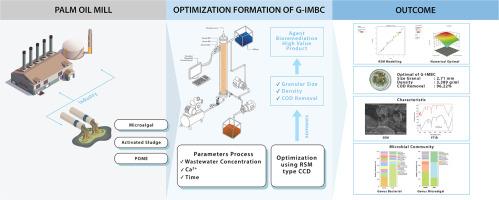用于棕榈油厂废水处理的颗粒原生微藻-细菌联合体(G-IMBC)技术的发展:优化,表征和微生物群落动态
Q2 Environmental Science
引用次数: 0
摘要
棕榈油厂废水(POME)仍然是一个主要的环境问题,由于其高有机负荷。本研究提出了一种开发和优化颗粒型原生微藻-细菌联合体(G-IMBC)的新方法,该方法可在序批式反应器(SBR)中有效处理POME。采用响应面法(RSM)对废水浓度(380 ~ 760 mg COD/L)、Ca 2 +添加量(40 ~ 100 mg/L)、制粒时间(8 ~ 24天)等关键参数进行建模和优化。在COD/L 622 mg、Ca 2 + 90 mg/L、22 d的优化条件下,颗粒大小(2.6 mm)和密度(3.37 g/mL)增强,R²值为0.93 ~ 0.97。G-IMBC提高了反应器的沉降性和整体性能。形态和元素分析证实了致密颗粒的成功发育,主要由碳(42.77%)和氧(33.54%)组成。宏基因组分析显示微生物群落多样,固氮菌属和腔藻属分别为优势菌属和微藻属。结构和微生物分析提供洞察造粒机制。系统对主要污染物的去除效果较好,COD去除率为82.25%±9.61,总氮去除率为72.70%±14.09,总磷去除率为71.68%±21.20。这些发现表明,这项技术可以作为POME治疗的有效策略。本文章由计算机程序翻译,如有差异,请以英文原文为准。

Development of granular indigenous microalgal-bacterial consortium (G-IMBC) technology for palm oil mill effluent treatment: Optimization, characterization, and microbial community dynamics
Palm oil mill effluent (POME) remains a major environmental concern due to its high organic load. This study presents a novel approach for the development and optimization of a Granular Indigenous Microalgal–Bacterial Consortium (G-IMBC) for effective POME treatment using a sequencing batch reactor (SBR). Response Surface Methodology (RSM) was employed to model and optimize key parameters, including wastewater concentration (380–760 mg COD/L), Ca²⁺ addition (40–100 mg/L), and granulation time (8–24 days). The optimized conditions 622 mg COD/L, 90 mg/L Ca²⁺, and 22 days—resulted in enhanced granule size (2.6 mm) and density (3.37 g/mL) with R² values of 0.93–0.97. The G-IMBC improved settleability and overall reactor performance. Morphological and elemental analyses confirmed the successful development of compact, dense granules dominated by carbon (42.77 %) and oxygen (33.54 %). Metagenomic analysis revealed a diverse microbial community, with Azotobacter and Coelastrum as the dominant bacterial and microalgal genera, respectively. Structural and microbial profiling providing insights into the granulation mechanism. The system demonstrated effective removal of major pollutants, with an average COD removal efficiency of 82.25 % ± 9.61, total nitrogen removal of 72.70 % ± 14.09, and Total Phosphorus removal of 71.68 % ± 21.20. These findings demonstrate that this technology can serve as an efficient strategy for POME treatment.
求助全文
通过发布文献求助,成功后即可免费获取论文全文。
去求助
来源期刊

Environmental Challenges
Environmental Science-Environmental Engineering
CiteScore
8.00
自引率
0.00%
发文量
249
审稿时长
8 weeks
 求助内容:
求助内容: 应助结果提醒方式:
应助结果提醒方式:


